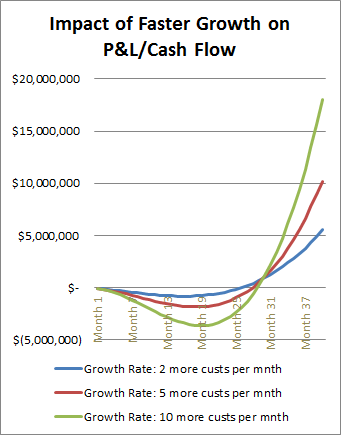 So your SaaS company has been around for a year or two now, and you think you've reached product/market fit.
So your SaaS company has been around for a year or two now, and you think you've reached product/market fit.
Things are looking good -- people are using your product, solving a problem they have, and you're consistently growing your userbase.
At this stage, not much could go wrong, right?
Just buckle down, keep improving the product, and in no time at all you'll have a billion dollar business on your hands.
Unfortunately, that's not going to be the case. It'll take more work, and you have new challenges to overcome.
Many SaaS companies fail having achieved product/market fit, and in this post I explain the key reason behind that failure.
Unfocused Growth
The majority of founding teams at SaaS companies tend to be technology and product focused. The early stages of building a software start-up involve lots of product development, and without core technical skills and product development skills, it's difficult to reach product/market fit.
The problem is that with founding teams leaning so heavily towards these skills, they tend to try and use new product functionality or technology to solve all their problems.
Not converting enough trials into customers? Develop new features.
Not attracting enough website traffic? Develop new features.
Not managing to get conversations with the press? Develop new features.
Customers not increasing their spend with you? Develop new features.
This works to some extent, but will only ever drive incremental growth, not the exponential growth your company really needs when it reaches product/market fit to swallow up the market.
Time to Get Serious About Sales & Marketing
To avoid this trap, stalling out and falling flat -- your company needs to develop a serious sales and marketing strategy.
You can't just rely on your great product to sell itself.
This may mean making some scary decisions:
- Hiring a sales director, and tasking them with building your first sales team.
- Hiring a marketing director, and tasking them with building an in-house marketing team.
- Partnering with marketing experts to develop and implement aspects of your marketing strategy.
- Investing in sales and marketing software like HubSpot and Salesforce CRM.
It's not enough to just keep improving your product anymore. People have already indicated that they'll buy your product as it stands -- you just need to get more people into the top of your marketing funnel, and convert as many of those people as possible into paying customers.
This represents a huge mental hurdle to many founding teams, as it can mean running up large losses. With customers billed monthly it can often take around 12 months to pay back the sales and marketing costs associated with acquiring one customer.
Being successful at this stage means acquiring customers as quickly as possible, and if you are growing rapidly, it's likely that your existing customer base will not be able to support your customer acquisition costs for new customers. That means you'll need funding, and a lot of it.
Effectively, the faster you grow, the more into the red you'll go, as nicely demonstrated by the graph below, courtesy of InsightSquared.com:
Note that whilst growing faster results in much greater short term losses, that in the long term, the rapidly growing SaaS company is miles ahead of its slower growing competitors.
So what are you going to do? Keep on with the incremental growth, and fail to maximise the opportunity available in the marketplace? Or go big and develop a serious sales and marketing strategy, raise funding and get those customers in through the door?
It's your decision, but I know which way I'd go.




